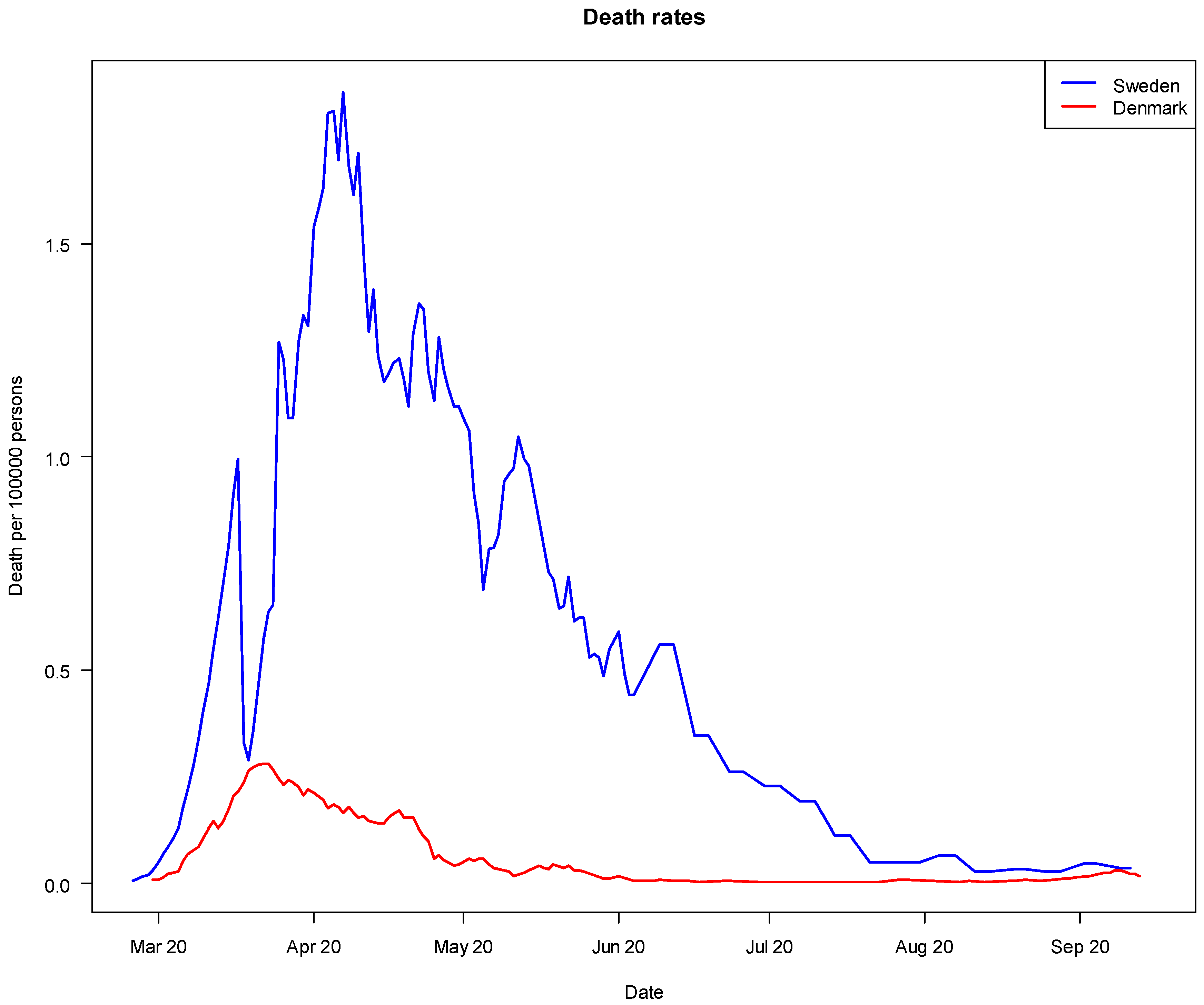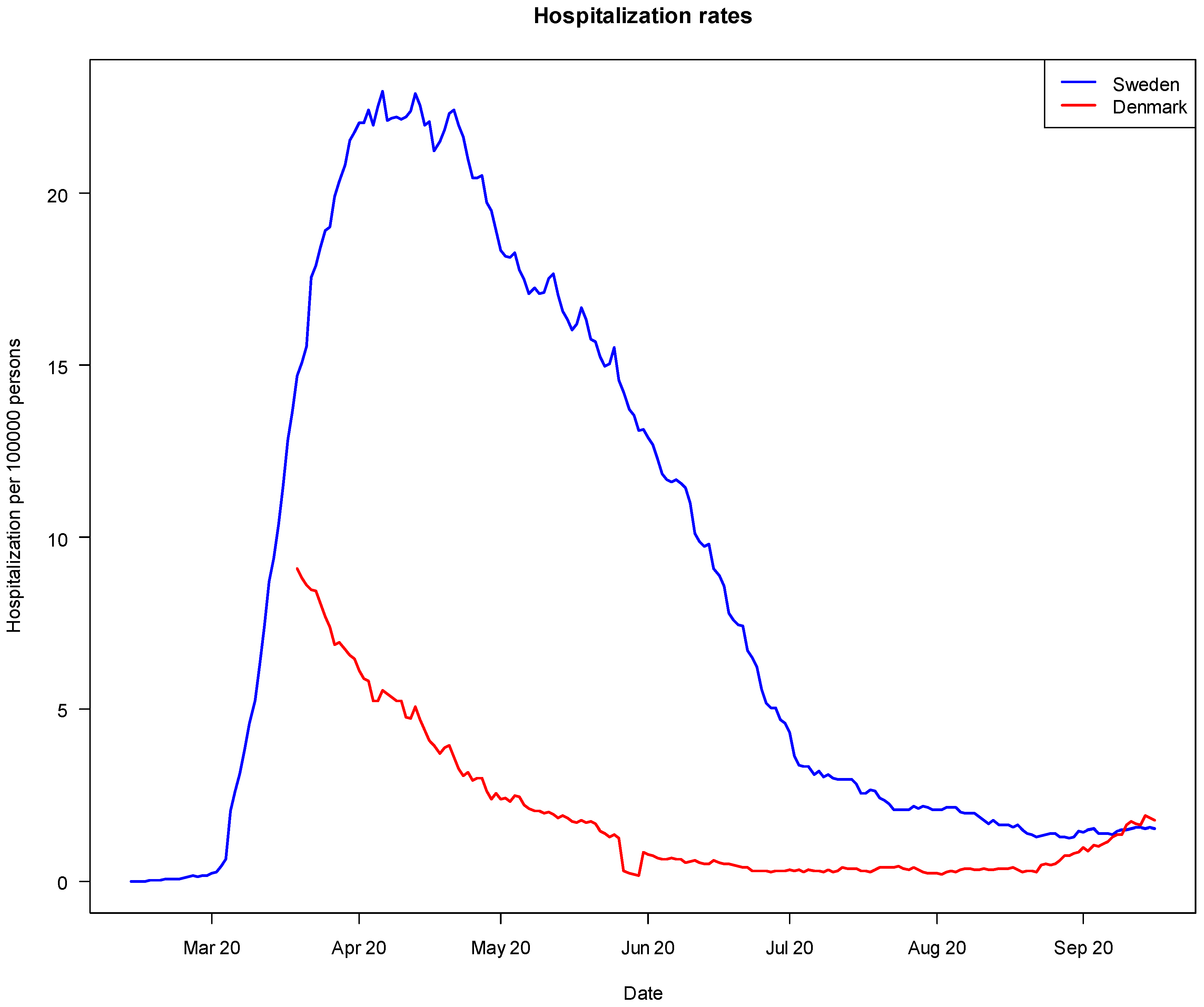Social Distancing Policies in the Coronavirus Battle: A Comparison of Denmark and Sweden
Abstract
:1. Introduction
2. Materials and Methods
2.1. Study Design and Definitions
2.2. Study Procedure
2.3. Study Context
3. Results
3.1. General Types of Policy Measures
3.1.1. Denmark
3.1.2. Sweden
3.1.3. Comparison
3.2. Categories of Social Distancing Policy Measures
3.2.1. Denmark
3.2.2. Sweden
3.2.3. Comparison
3.3. Policy Adopters
3.3.1. Denmark
3.3.2. Sweden
3.3.3. Comparison
3.4. Time of Adoption
3.4.1. Denmark
3.4.2. Sweden
3.4.3. Comparison
3.5. Policy Implementers
3.5.1. Denmark
3.5.2. Sweden
3.5.3. Comparison
3.6. Policy Target Groups
3.6.1. Denmark
3.6.2. Sweden
3.6.3. Comparison
4. Discussion
5. Conclusions
Author Contributions
Funding
Institutional Review Board Statement
Informed Consent Statement
Data Availability Statement
Acknowledgments
Conflicts of Interest
References
- World Health Organization. COVID 19—Public Health Emergency of International Concern (PHEIC)—Global Research and Innovation Forum: Towards a Research Roadmap; WHO: Geneva, Switzerland, 2020; Available online: https://www.who.int/publications/m/item/covid-19-public-health-emergency-of-international-concern-(pheic)-global-research-and-innovation-forum (accessed on 17 October 2021).
- Jefferson, T.; Del Mar, C.B.; Dooley, L.; Ferroni, E.; Al-Ansary, L.A.; Bawazeer, G.A.; van Driel, M.L.; Nair, S.; Jones, M.A.; Thorning, S.; et al. Physical interventions to interrupt or reduce the spread of respiratory viruses. Cochrane Database Syst. Rev. 2011, 7, CD006207. [Google Scholar] [CrossRef] [PubMed] [Green Version]
- Rashid, H.; Ridda, I.; King, C.; Begun, M.; Tekin, H.; Wood, J.G.; Booy, R. Evidence compendium and advice on social distancing and other related measures for response to an influenza pandemic. Paediatr. Respir. Rev. 2015, 16, 119–126. [Google Scholar] [CrossRef] [PubMed]
- Fong, M.W.; Gao, H.; Wong, J.Y.; Xiao, J.; Shiu, E.Y.C.; Ryu, S.; Cowling, B.J. Nonpharmaceutical measures for pandemic influenza in nonhealthcare settings—social distancing measures. Emerg. Infect. Dis. 2020, 26, 976–984. [Google Scholar] [CrossRef] [PubMed]
- Mahtani, K.R.; Heneghan, C.; Aronson, J.K. What is the Evidence for Social Distancing during Global Pandemics? A Rapid Summary of Current Knowledge; On behalf of the Oxford COVID-19 Evidence Service Team, Centre for Evidence-Based Medicine, Nuffield Department of Primary Care Health Sciences, University of Oxford: Oxford, UK, 2020. [Google Scholar]
- Marin, C. Europe Versus Coronavirus—Putting the Danish Model to the Test; Institut Montaigne: Paris, France, 2020; Available online: www.institutmontaigne.org/en/blog/europe-versus-coronavirus-putting-danish-model-test (accessed on 17 October 2021).
- Danish Government. Coronavirus og Tiltag for at Inddæmme Smitten. 2020. Available online: www.regeringen.dk/nyheder/2020/pressemoede-i-statsministeriet-om-covid-19 (accessed on 17 October 2021).
- Swedish Government. Strategi Med Anledning av det nya Coronaviruset. 2020. Available online: www.regeringen.se/regeringens-politik/regeringens-arbete-med-anledning-av-nya-coronaviruset/strategi-med-anledning-av-det-nya-coronaviruset (accessed on 17 October 2021).
- Anderberg, J. Flocken—Berättelsen om hur Sverige valde väg under Pandemin; Albert Bonniers Förlag: Stockholm, Sweden, 2021. [Google Scholar]
- Coronavirus Resource Center (CRC). John Hopkins University of Medicine. 2020/2021. Available online: https://coronavirus.jhu.edu/map.html (accessed on 17 October 2021).
- Esping-Andersen, G. The Three Worlds of Welfare Capitalism; Polity Press: Cambridge, UK, 1990. [Google Scholar]
- Bowen, G.A. Document analysis as a qualitative research method. Qual. Res. J. 2009, 9, 27–40. [Google Scholar] [CrossRef] [Green Version]
- Gudi, S.K. Language Matters: Is It Social or Physical Distancing to Be Followed during the COVID-19 Pandemic? PLoS Blogs, Your Say. 29 May 2020. Available online: https://yoursay.plos.org/2020/05/29/language-matters-is-it-social-or-physical-distancing-to-be-followed-during-the-covid-19-pandemic/ (accessed on 17 October 2021).
- Esser, F.; Vliegenthart, R. Comparative research methods. In The International Encyclopedia of Communication Research Methods; Matthes, J., Davis, C.S., Potter, R.F., Eds.; John Wiley: New York, NY, USA, 2017. [Google Scholar] [CrossRef] [Green Version]
- Cairney, P. Evidence and policy making. In What Works Now? Boaz, A., Davies, H., Fraser, A., Nutley, S., Eds.; Policy Press: Bristol, UK, 2019; pp. 21–40. [Google Scholar]
- Hill, M. The Public Policy Process; Pearson Longman: Harlow, UK, 2009. [Google Scholar]
- Vedung, E. Public Policy and Program Evaluation; Routledge: New York, NY, USA, 2017; pp. 121–136. [Google Scholar] [CrossRef]
- Vedung, E. Policy instruments: Typologies and theories. In Carrots, Sticks, and Sermons: Policy Instruments and Their Evaluation; Bemelmans-Videc, M.-L., Rist, R.C., Vedung, E., Eds.; Routledge: New York, NY, USA, 2017; pp. 21–58. [Google Scholar] [CrossRef]
- Nilsen, P. Making sense of implementation theories, models and frameworks. Implement. Sci. 2015, 10, 53. [Google Scholar] [CrossRef] [PubMed] [Green Version]
- Damschroder, L.J. Clarity out of chaos: Use of theory in implementation research. Psychiatry Res. 2020, 283, 1–6. [Google Scholar] [CrossRef] [PubMed]
- Jensen, L. Steering from the Centre in Denmark. In Steering from the Centre: Strengthening Political Control in Western Democracies; Dahlström, C., Peters, B.G., Pierre, J., Eds.; University of Toronto Press: Toronto, ON, Canada, 2011. [Google Scholar] [CrossRef]
- Christiansen, P.M.; Ibsen, M.; Christensen, J.G. Politik og Forvaltning; Academica: Århus, Denmark, 2006. [Google Scholar]
- Blom-Hansen, J.; Christiansen, P.M.; Pallesen, T.; Serritzlew, S. (Eds.) Offentlig Forvaltning—Et Politologisk Perspektiv; Hans Reitzels Förlag: Copenhagen, Denmark, 2014. [Google Scholar]
- Jacobsson, B.; Sundström, G. Governing state agencies: Transformations in the Swedish Administrative Model. Scores Rapportserie 2007:5. Stockholms Centrum för Forskning om Offentlig Sektor. 2007. Available online: https://www.score.su.se/polopoly_fs/1.26595.1320939800!/20075.pdf (accessed on 17 October 2021).
- Hall, P. The Swedish Administrative Model. In The Oxford Handbook of Swedish Politics; Pierre, J., Ed.; Oxford University Press: Oxford, UK, 2015; pp. 299–314. [Google Scholar] [CrossRef]
- Premfors, R.; Ehn, P.; Haldén, E.; Sundström, G. Demokrati & Byråkrati; Studentlitteratur: Lund, Sweden, 2009. [Google Scholar]
- Premfors, R.; Sundström, G. Regeringskansliet; Liber: Malmö, Sweden, 2007. [Google Scholar]
- Larsson, T.; Bäck, H. Governing and Governance in Sweden; Studentlitteratur: Lund, Sweden, 2008. [Google Scholar]
- Ahlbäck Öberg, S.; Wockelberg, H. Agency control or autonomy? Government steering of Swedish government agencies 2003–2017. Int. Public Manag. J. 2020, 24, 330–349. [Google Scholar] [CrossRef]
- Sundhedsstyrelsen Sundhedsstyrelsens Borgerrettede Kommunikationsindsats om ny Coronavirus/COVID-19. Status pr. 5. maj 2020. Available online: https://www.sst.dk/-/media/Udgivelser/2020/Corona/Kommunikationsindsats/Statusrapport-over-Sundhedsstyrelsens-kommunikationsindsats-under-ny-coronavirus.ashx?la=da&hash=8D7685B1FAE0E146876488FB3775C2820AACD4CA (accessed on 17 October 2021).
- Sundhedsstyrelsen. About Us. 2021. Available online: https://www.sst.dk/en/English/About-us (accessed on 17 October 2021).
- Folkhälsomyndigheten. Our Mission—To Strengthen and Develop Public Health. 2021. Available online: https://www.folkhalsomyndigheten.se/the-public-health-agency-of-sweden/ (accessed on 17 October 2021).
- Folkhälsomyndigheten. About Laws, Ordinances and Regulations. 2021. Available online: https://www.folkhalsomyndigheten.se/publicerat-material/foreskrifter-och-allmanna-rad/om-lagar-forordningar-och-foreskrifter/ (accessed on 17 October 2021).
- HSLF-FS 2020:12, Folkhälsomyndighetens Föreskrifter och Allmänna råd om allas Ansvar att Förhindra Smitta av COVID-19 m.m. Available online: https://www.folkhalsomyndigheten.se/contentassets/0ac7c7d33c124428baa198728f813151/hslf-fs-2020-12u.pdf (accessed on 17 October 2021).
- Ellingsen, T.; Roine, J. Sweden and the Virus: Public Policy and the Swedish Model. What Was the Swedish Government’s Approach to the Pandemic, and How Was It Received in Sweden? Preprint from Sweden Through the Crisis, Forthcoming Publication by SIR; The Stockholm School of Economics Institute for Research: Stockholm, Sweden, 2020. [Google Scholar]
- Wenander, H. Sweden: Non-binding rules against the pandemic—Formalism, pragmatism and some legal realism. Eur. J. Risk Regul. 2021, 12, 127–142. [Google Scholar] [CrossRef] [PubMed]
- Cairney, P. Understanding Public Policy—Theories and Issues; Basingstoke: Palgrave Macmillan, 2012. [Google Scholar]
- Danish Parliament. Håndteringen af COVID-19 i Foråret 2020: Rapport Afgivet af den af Folketingets Udvalg for Forretningsordenen Nedsatte Udredningsgruppe vedr. Håndteringen af COVID-19; Folketinget: Copenhagen, Denmark, 2021; Available online: https://www.ft.dk/-/media/sites/ft/pdf/publikationer/haandtering-af-covid19-foraar-2020.ashx (accessed on 17 October 2021).
- Pierre, J. Nudges against pandemics: Sweden’s COVID-19 containment strategy in perspective. Policy Soc. 2020, 39, 478–493. [Google Scholar] [CrossRef]
- Örstadius, K.; Delin, M.; Eriksson, K. Så gick det till när regeringen gav taktpinnen till expertmyndigheten. Dagens Nyheter. 15 March 2020. Available online: https://www.dn.se/nyheter/sverige/sa-gick-det-till-nar-regeringen-gav-taktpinnen-till-expertmyndigheten/ (accessed on 17 October 2021).
- Statskontoret. Förvaltningsmodellen under Coronapandemin; Om Offentlig Sektor: Stockholm, Sweden, 2020; Available online: https://www.statskontoret.se/publicerat/publikationer/2020/forvaltningsmodellen-under-coronapandemin/ (accessed on 17 October 2021).
- Esaiasson, P.; Sohlberg, J.; Ghersetti, M.; Johansson, B. How the coronavirus crisis affects citizen trust in institutions and in unknown others: Evidence from ‘the Swedish experiment’. Eur. J. Political Res. 2021, 60, 748–760. [Google Scholar] [CrossRef]
- Harring, N.; Jagers, S.C.; Löfgren, Å. COVID-19: Large-scale collective action, government intervention, and the importance of trust. World Dev. 2021, 138, 1–4. [Google Scholar] [CrossRef]
- Siegrist, M.; Zingg, A. The role of public trust during pandemics: Implications for crisis communication. Eur. Psychol. 2014, 19, 23–32. [Google Scholar] [CrossRef]
- Ortiz-Ospina, E.; Roser, M. Trust. 2016. Available online: https://ourworldindata.org/trust (accessed on 17 October 2021).
- Holmberg, S.; Rothstein, B. Minskar mångkulturella samhällen den sociala tilliten? In Regntunga Skyar; Andersson, U., Carlander, A., Öhberg, P., Eds.; SOM-Undersökningen 2019, SOM-Rapport nr 76; Göteborgs Universitet, SOM-Institutet: Göteborg, Sweden, 2020. [Google Scholar]


| Organization | Website | Document Type | |
|---|---|---|---|
| Denmark | The Danish Parliament | www.folketinget.dk (accessed on 17 October 2021) | Laws, news/press releases |
| The Danish Government | www.regeringen.dk (including websites of relevant ministries) (accessed on 17 October 2021) | News/press releases, travel advice | |
| Retsinformation—The official legal information system of Denmark | https://www.retsinformation.dk/ (accessed on 17 October 2021) | Laws, executive orders | |
| The Danish Health Authority | www.sst.dk (accessed on 17 October 2021) | Recommendations, guidelines, instructions, news/press releases | |
| The State Serum Institute | www.ssi.dk (accessed on 17 October 2021) | News/press releases | |
| Sweden | The Swedish Government | https://www.regeringen.se/ (including websites of relevant ministries) (accessed on 17 October 2021) | News/press releases, travel advice |
| The Swedish Code of Statutes | https://svenskforfattningssamling.se (accessed on 17 October 2021) | Laws, executive orders | |
| The Public Health Agency in Sweden | https://www.folkhalsomyndigheten.se (accessed on 17 October 2021) | Recommendations, general guidelines, news/press releases |
| Aspect | Description | |
|---|---|---|
| 1 | General types of policy measures | What types of general policy measures were adopted to achieve compliance with social distancing? The measures were classified into sticks and sermons policy measures, in accordance with Vedung [17,18] |
| 2 | Categories of social distancing policy measures | What specific types of social distancing policy measures were adopted? The different types of policy measures were classified based on a taxonomy described by Rashid et al. [3]: school closure, workplace closure, home working, self-isolation of cases, quarantine of contacts, mobility restrictions, cancellation of mass events. However, further types were also explored inductively |
| 3 | Policy adopters | Who was the formal policy adopter behind the policy measure? |
| 4 | Time of adoption | When was the policy measure adopted (1 March 2020 to 1 October 2020)? |
| 5 | Policy implementers | Which organizations were responsible for implementation of the adopted policy measure? |
| 6 | Policy target group | Who are the individuals the policy measure ultimately seeks to influence? |
Publisher’s Note: MDPI stays neutral with regard to jurisdictional claims in published maps and institutional affiliations. |
© 2021 by the authors. Licensee MDPI, Basel, Switzerland. This article is an open access article distributed under the terms and conditions of the Creative Commons Attribution (CC BY) license (https://creativecommons.org/licenses/by/4.0/).
Share and Cite
Seing, I.; Thórný Stefánsdóttir, N.; Wassar Kirk, J.; Andersen, O.; Tjørnhøj-Thomsen, T.; Kallemose, T.; Vedung, E.; Vrangbæk, K.; Nilsen, P. Social Distancing Policies in the Coronavirus Battle: A Comparison of Denmark and Sweden. Int. J. Environ. Res. Public Health 2021, 18, 10990. https://doi.org/10.3390/ijerph182010990
Seing I, Thórný Stefánsdóttir N, Wassar Kirk J, Andersen O, Tjørnhøj-Thomsen T, Kallemose T, Vedung E, Vrangbæk K, Nilsen P. Social Distancing Policies in the Coronavirus Battle: A Comparison of Denmark and Sweden. International Journal of Environmental Research and Public Health. 2021; 18(20):10990. https://doi.org/10.3390/ijerph182010990
Chicago/Turabian StyleSeing, Ida, Nina Thórný Stefánsdóttir, Jeanette Wassar Kirk, Ove Andersen, Tine Tjørnhøj-Thomsen, Thomas Kallemose, Evert Vedung, Karsten Vrangbæk, and Per Nilsen. 2021. "Social Distancing Policies in the Coronavirus Battle: A Comparison of Denmark and Sweden" International Journal of Environmental Research and Public Health 18, no. 20: 10990. https://doi.org/10.3390/ijerph182010990
APA StyleSeing, I., Thórný Stefánsdóttir, N., Wassar Kirk, J., Andersen, O., Tjørnhøj-Thomsen, T., Kallemose, T., Vedung, E., Vrangbæk, K., & Nilsen, P. (2021). Social Distancing Policies in the Coronavirus Battle: A Comparison of Denmark and Sweden. International Journal of Environmental Research and Public Health, 18(20), 10990. https://doi.org/10.3390/ijerph182010990






